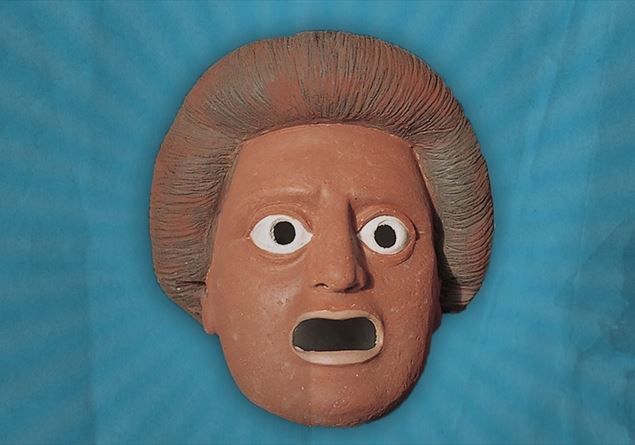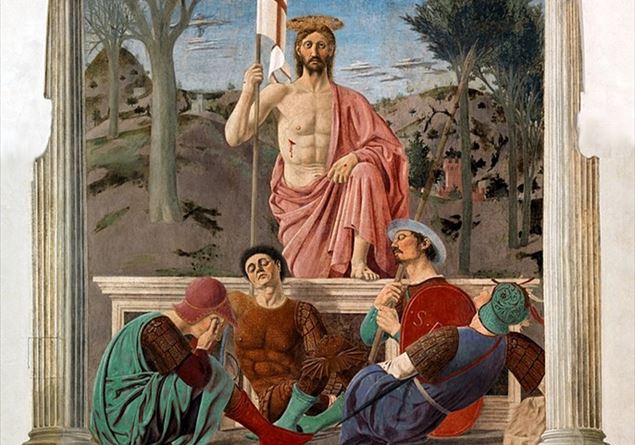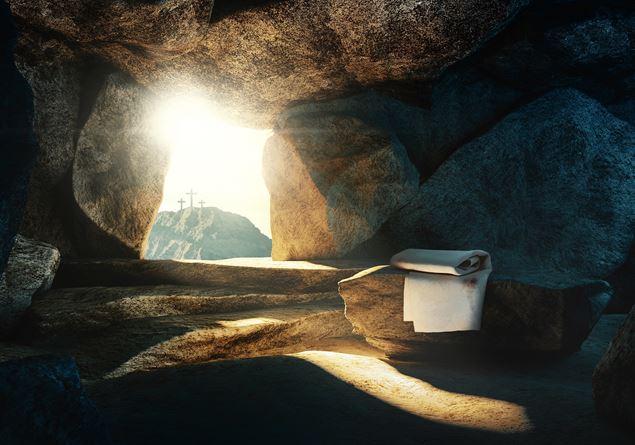Easter is the culmination of the Easter triduum, the center and heart of the whole liturgical year. It is the most solemn feast of the Christian religion which continues with the eighth of Easter and with the liturgical time of Easter that lasts 50 days, incorporating the festive of the ascension, up to the solemnity of the Pentecost.
What does the word “Easter” mean?
Derives from the Greek: Paschain turn from the Aramaic Pasah And it means properly “passing beyond”, therefore “passage”. The Jews remembered the passage through the Red Sea from Schiavitu of Egypt to liberation. For Christians it is the feast of the transition from death to the life of Jesus Christ.
A table set for the Pesach Seder
What are the origins of this party?
At the Jews Easter (Pesach) was originally linked to agricultural activity and was the festival of the collection of the very first fruits of the countryside, starting with wheat. Other parties, just to remind them, were the Weeks partywhich celebrated the grain collection in early June, and the Tabernacoli Festivalthat is, of the harvest, in September.
Subsequently, Easter becomes the annual celebration of the liberation of the Jews from slavery, meaning that it was added to the other, as a memory of the escape from Egypt and the fact that with the blood of the lambs the jambs of the doors had been painted so that the exterminating angel, as the Bible says, passing from those houses, spared the firstborn.
Even today, the Easter dinner at the Jews takes place according to a precise order said Seder. We feed on bitter foods to remember the bitterness of the Egyptian slavery and the amazement of the freedom found.
To celebrate Easter, the Israelites in the time of Jesus went to Jerusalem every year. He too went there. His death took place, in fact, on the occasion of the Jewish Easter. For Christians it is the Easter lamb that saves from death, the new bread that makes new (cf. 1Cor 5,7-8)

Why do you eat lamb?
The tradition of consuming the lamb for Easter derives from Pesachthe Passover. In fact, the lamb is part of the origin of this holiday. In particular, reference is made to when God announced to the people of Israel that he would have freed him from the slavery in Egypt saying “on this night I will pass through Egypt and hit every egyptian eldest son, both among the people and between cattle”. Thus ordering the people of Israel to mark their doors with lamb blood so that he was able to recognize who to hit with his punishment and who does not. In addition, in the past there was a commandment regarding the Jewish Easter who said to make the offer of the Lamb on the 14th of the Jewish month of Nisan and to consume the Sacrifice of Pesach that same night.
With Christianism, The symbol of the immolated lamb for everyone’s salvation becomes Christ himself And its sacrifice has a redemption value.
One of the Easter culinary traditions is to prepare the lamb of almond paste.
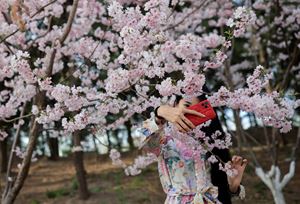
Flowered trees in spring in China (Reuters)
Why is the Easter date mobile?
Because it is linked to the Spring full moon. The dating of Easter, in the Christian world, was a source of serious controversies between the churches of the East and Western, the first was made up of converted Jews and celebrated it immediately after the Jewish Easter and that is, in the evening of the full moon, the 14 Nisan, the first month of the Jewish year; So always on different days of the week. Only with the Council of Nicea of 325it was obtained that it was celebrated on the same day throughout Christianity and that is by adopting the western rite, fixing it on the Sunday that followed the plenilunio of spring. Today The celebration falls between March 22 and April 25th By nameing it so low or high, according to the period in which it happens.
Being a mobile party, it determines the date of other celebrations connected to it, such as the Lent, Holy Week, Ascension, Pentecost. The Church contemplates the obligation of the Easter precept for Catholics, that is, to confess and receive the Eucharist at least once in the Easter period.
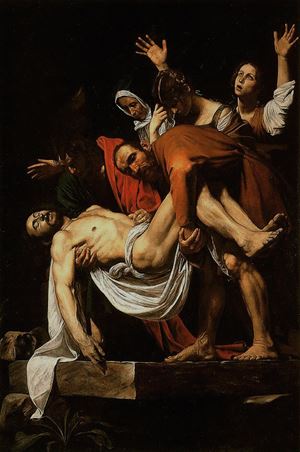
Caravaggio, Deposition in the sepulcher, 1602-04, Pinacoteca Vaticana
What do the Gospels say? From the “temporary” burial to the resurrection of Jesus
After death on the cross, Jesus’ burial was a provisional operation, when being an evening now and approached with sunset on Jewish Saturday, in which any activity was prohibitedthe body of Jesus was wrapped in a candid sheet and deposited in the tomb of the new excavated in the rock, belonging to Giuseppe D’Arimateamember of the Sanhedrin, but now a follower of Jesus. The operations necessary for this type of burial, which was not the inhumation in the soil, namely sprinkling the body with perfumes and conservative ointments and the winding of the same body with bands or bandages (we have the example in the story of Lazzaro resurrected by the same Jesus); These operations, we said, were postponed to after Saturday by the Pious Women, who after preparing the aromas and seen where the body of Jesus had been deposed, eventually moved away.
After the Parasceve (Eve on Saturday) So just after buried Jesus, the priests and the Pharisees went to Pilate by telling him that they had remembered “that that impressor when he was still alive, he said: After three days I will raise. He therefore orders that the sepulcher is supervised until the third day, so that the disciples do not come, the ruby and then tell the people: he risen from the dead. So the latter imposture would be worse than the first! ». And Pilate, according to the only Gospel of Matteo, authorized the sepulcher seal and arranged some guards to control him.
Spent on Saturday, in which everyone observed the rest, Maria di Magdala, Maria di Cleofa and Salome, They completed the preparation of the perfumes and went to the tomb of good time to complete the angry of the body and the bandage; Along the road they said among them, those who could help them move the heavy circular stone, which closed the low opening of the sepulcher, which was made up of two rooms dug in the rock, consisting of a small atrium and in the sepulchral cell; The latter containing a kind of stone rise, on which the corpse was placed. When they arrived, according to the Gospels, there was an earthquake, a blazing angel descended from the sky, approached the sepulcher he rolled the stone and settled on it; The guards taken from great fright fell overwhelmed. But the angel turned to the defeating women, telling them: “Don’t be afraid, you! I know you are looking for Jesus the crucifix. It’s not here. He risen from the dead, and here, he precedes you in Galilee; You will see it there». Continuing with the story of the Gospel of Matteo, the women ran away to give announcement to the disciples.
It should be remembered that the resurrection of Jesus is announced by some women, who according to the ancient Jewish law, were incapacitated to testify, therefore with this event that sees them messenger and witnesses, a historical event in Jewish sociability is also inserted. When the women reached the apostles and reported the incident, they ran to the sepulcher, but Pietro and Giovanni Corsero ahead, at the sepulcher he first arrived young and faster, but on the threshold he stopped after seeing the sheet (shy) on the ground, Pietro who arrived, entered first and found that the sheet was on the ground, while the Sudario, used to rest it on the head of the deceased. Folded up in a corner, then John also entered and both understood and believed in what Jesus himself, had previously said about his resurrection.
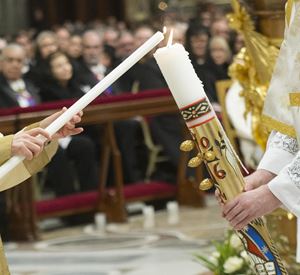
A moment of the Easter Vigil in the Basilica of San Pietro (Ansa)
How does the liturgy of the Easter vigil compose?
For Sant’Agostino the Easter is “the mother of all the holy wakefulness, during which the whole world has remained awake”. During this night, the Church celebrates the resurrection of Christ, baptizing new Christians (the catechumens) and asking those who are already renewing all the commitments of their baptism together.
Easter vigil is a complex and unitary celebration, which takes place in four following moments:
1) Liturgy of light Which begins with the blessing of the fire, the preparation and ignition of the candle as “light of Christ”, and the procession with which it is introduced in the dark church, which is therefore illuminated by the candles of the faithful on the Easter candle. The solemn Easter Annunzio follows, also called by the initial word Latina Exultet;
2) Liturgy of the Word With nine readings, seven drawn from the Old Testament and the last two from the new;
3) baptismal liturgy;
4) Eucharistic liturgy. The rite takes place in the night, a symbol of humanity that without Christ is immersed in the darkness of ignorance and error, sin and death.
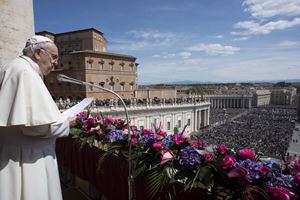
The Urbi et orbi message of Pope Francis on the occasion of Easter 2022 (ANSA)
What is the Easter blessing Urbi et orbi?
Urbi et orbi is a Latin expression that means “To the city (of Rome) and the world”. The blessing Urbi et orbi is the first blessing made by a pope, immediately after the election in conclave, by the central lodge of the Vatican Basilica.
It is also widespread by the pontiff in the days of Christmas and Easter to the crowd gathered in St. Peter’s Square and on particular occasions.
The blessing, usually accompanied by a message, involves the acquittal of all time sins for all present in St. Peter’s Square and for those who receive it through the various means of communication.

A chocolate egg (ANSA)
Why are egg eaten?
The tradition of decorating eggs already dates back to the first Christians who painted red eggs, to remember the blood of Christ, and decorated them with crosses or other symbols (a tradition that still lasts today in the Orthodox and Christian-horient countries). The egg symbolism is evident: The life was born from the egg which in turn was associated with the rebirth of Christ and therefore with Easter. In reality, the eggs decorated according to this symbolism would also have gone well for Christmas, on the occasion of the birth of Christ, but according to some studies the tradition of Easter eggs was strengthened by a typically Easter custom: Lent, the period of forty days before Easter in which believers are required to fast and abstinence. In this period it is forbidden to eat meat.
In the past, and still in the oriental Christian churches, it was forbidden to eat eggs. However, it was difficult to force the hens not to deposit eggs at that time, so the first Christians were with a surplus of eggs that they could not eat.
From the need to do something, the tradition of boiling them would have been born to make them become hard as stones and then paint them with sacred and symbolic colors.
